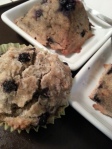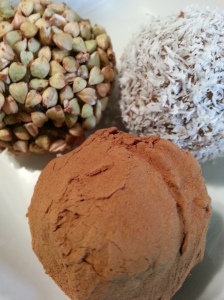I woke up with a hankering for blueberry muffins fueled by my want to feed my gal pals something good for them.
This was a first try and I was sooo happy with them. Not sweet, but sweet enough…and next time I may make a maple icing to drizzle on top for an extra sweet kiss.
Now, that was yesterday…and the three of us gobbled up the muffins and was fueled up for our commercial lifestyle test shoot we did together… we had fun! You can check out www.ActorsEssentials.com for my sweet galpal’s growing photography portfolio 🙂
Guess what today is? bad me day… yes, BAD ME. National Doughnut Day. Actually, I was really doing well–I made a seed-based raw vegan doughnut that looked gorgeous and tasted alright, but it was sure healthy! To be honest, I used sunflower seeds instead of the guaranteed goodness of brazil nuts because a friend recently almost died from his nut/legume allergy and I was motivated to risk the nut to seed swap. Next time…I’ll stick to brazil nuts for Raw doughnuts… However, because it was so protein dense, with added maca, and flax seeds, I was beyond full! I should’ve just stopped with my blueberry muffin snack mid-morning, but alas…

My husband brings me a whole box of Krispy Kreme donuts plus their free Boston Creme version… and 3 donuts later, did I ever start to pay for them!! lotta dough all at once, ya know? carb coma after ouchy belly… lucky for me I had time to nap. 
Here’s the recipe for the GF & V coconut flour muffins that actually tasted much better to me than the deadly doughnuts… guilt-free and good… hmm– that’s hard to beat, eh?
Blueberry muffins with hemp seeds GF & Vegan
Ingredients:
¾ cup Bob’s Red mill all purpose GF flour (impt. b/c of the tapioca flour in it)
1 cup coconut flour
½ cup cassava flour
2 teaspoons baking powder
1 teaspoon baking soda
1/2 teaspoon Himalayan pink salt
3 packets of stevia (or ½ cup of sweetener of choice)
½ cup agave or honey
4 dashes of Ceylon cinnamon
2 dashes of ground nutmeg
1/2 cup organic virgin coconut oil
3 flax/chia egg replacements
1/2 – 1 full cup non-dairy milk (I used coconut-almond blend)
2 teaspoons vanilla extract
1 overripe mashed banana
2 cups organic blueberries (I like to use frozen)
2 tablespoons of hemp seeds
Grade B maple syrup, optional
Instructions:
Preheat the oven to 350ºF. Line muffin pan with liners or use silicone baking mold.. I like using both for variety of presentation.
In a large mixing bowl, whisk together the flours, starch, sugar, baking powder, baking soda, sea salt, cinnamon and nutmeg. Sift all into another bowl.
In a stainless steel bowl, warm coconut oil with mashed banana; mix egg replacers with non-dairy milk, and vanilla and beat to combine. When just warm enough to have coconut oil still liquid, combine both liquidy mixes and then add to dry mixture and continue folding/beat together until smooth. It will not be your typically wet batter b/c coconut flour will soak it all up. Just drizzle additional nondairy milk until all mixed up enough while adding hemp seeds. Add blueberries and mixed gently by hand. Do not over mix—little wild frozen blueberries will mash quickly, so frozen works well here.
Using a spoon, drop the dough balls into the 12 muffin cups and smooth tops with spoon. Bake in the center of the oven for 22-25 minutes, until domed and golden brown.
I think a nice maple syrup drizzle would be perfect if a morning kiss of sweetness is desired.
And some notes on tapioca vs. cassava flour to tickle the brain as much as we are tickling the tastebuds today:
Nutrition
• The cassava is a staple food for about 500 million people around the world. The edible parts of the cassava are the roots and leaves. The roots resemble sweet potatoes and are rich in carbohydrates, and the leaves are rich in vitamins and protein. Although similar to potatoes, the cassava is higher in potassium and has twice the fiber content.
Cassava Flour and Tapioca Flour
• Cassava Flour is made by cooking, drying and then grinding the cassava roots. This flour is different from tapioca flour, which is made from the leaves of the cassava plant. Both of them are gluten-free, so they are used widely by those with celiac disease or gluten intolerance.
•
Uses of Cassava Flour
• Cassava is often used as a substitute for wheat flour, especially to make breads, cakes, pasta and dumplings. It is also used to make starchy custards and puddings. In countries where wheat has to be imported and is in limited supply, bread is made by mixing cassava flour with wheat flour. Cassava flour is known to attract fewer insects and pests than normal wheat flour. Cassava flour’s starchy texture makes it an excellent thickener, and it is used to thicken soups, baby foods, puddings, sauces and gravies. Cassava flour is also used as a binding agent in sausages and processed meats to keep the meat together and ensure that it does not dry out completely while it is cooked.
Uses of Tapioca Flour
• Tapioca flour, which is made from the ground leaves of the cassava plant, is also used as a substitute for wheat or other carbohydrates. It is a very popular flour among bakers, because it gives breads and cakes a white finish and a chewy texture. It has no strong aroma of its own, so it is an ideal choice as a thickener because it does not interfere with or overpower the taste or smell of any dish.
• Copied from ehow:
http://www.ehow.com/info_8650307_uses-cassava-flour.html
oh… in case you want to see my healthy and very pretty doughnuts…
here are what I am calling my DA-DONUT-Os —
(but, again, I think I would have been happiest if I just stopped with my muffins…) *sigh.

Now, off to a proper, balanced dinner with my thoughtful husby. muah*